 It was a monsoon in Huntsville, Alabama last night as I headed to the church building for this podcast only to get halfway there and get the call from trusty-techer Jen to let me know that the power was off in our little studio (and all over that part of town). Now we know there are lots of you who assemble for the podcasts and we know your time is important, so we began making calls, figuring out places and devices we might use as a last resort. Thirty minutes later, as Jen was driving into my neighborhood, we got the call that power was back on at the building. The clock had been ticking, though, and we knew we’d be super late, at this point, if we moved the podcast back to the studio. So picture me moving supplies and large yard art that I’d been crafting out of the camera’s view, Jen opening up an iPad to find it was completely battery-drained, my laptop acting like it has never even heard of facebook live (what’s up with that, anyway?), a big yellow extension cord that wielded no power, Holly over at her house, figuring out how to field comments, and sweet Melissa Davidson, who was super prepared to cohost, realizing she did not have time to even make it all the way to the eastern Madison sticks, where I live. Imagine, Glenn coming in to do a ZOOM about a book that a few men are completing and realizing he’s walked into another BIG ZOOM-ish project. Relegated to the porch, I can hear him saying “Good evening, gentlemen!…” while I’m trying to say a prayer and “Goodnight ladies!” It was chaotic and you were patient and Jen’s a hero. And that boy we just met who’s living in our cabin probably thought “What has happened to the band with of this internet?”…And you can watch the study here: https://livestream.com/whcoc/for-women. When there’s no power in the studio, there’s still plenty in the Word. Below are the photos that did not get their debut last night: The first is a bunch of Diggers in the Pool of Siloam (John 9). The rest are on various places on the Mount of Olives. Both are from May, 2019, when we were digging in Israel and both are mentioned in the show. The fourth one(far left) is at the site believed to be the Garden of Gethsemane on the Mount of Olives. Notice the ossuaries in the second photo. I’m told, for a price, people can still be buried on the Mount of Olives (and many still want to be). Blessings as you study. Two more months of the glory study. An eternity of the GLORY!
It was a monsoon in Huntsville, Alabama last night as I headed to the church building for this podcast only to get halfway there and get the call from trusty-techer Jen to let me know that the power was off in our little studio (and all over that part of town). Now we know there are lots of you who assemble for the podcasts and we know your time is important, so we began making calls, figuring out places and devices we might use as a last resort. Thirty minutes later, as Jen was driving into my neighborhood, we got the call that power was back on at the building. The clock had been ticking, though, and we knew we’d be super late, at this point, if we moved the podcast back to the studio. So picture me moving supplies and large yard art that I’d been crafting out of the camera’s view, Jen opening up an iPad to find it was completely battery-drained, my laptop acting like it has never even heard of facebook live (what’s up with that, anyway?), a big yellow extension cord that wielded no power, Holly over at her house, figuring out how to field comments, and sweet Melissa Davidson, who was super prepared to cohost, realizing she did not have time to even make it all the way to the eastern Madison sticks, where I live. Imagine, Glenn coming in to do a ZOOM about a book that a few men are completing and realizing he’s walked into another BIG ZOOM-ish project. Relegated to the porch, I can hear him saying “Good evening, gentlemen!…” while I’m trying to say a prayer and “Goodnight ladies!” It was chaotic and you were patient and Jen’s a hero. And that boy we just met who’s living in our cabin probably thought “What has happened to the band with of this internet?”…And you can watch the study here: https://livestream.com/whcoc/for-women. When there’s no power in the studio, there’s still plenty in the Word. Below are the photos that did not get their debut last night: The first is a bunch of Diggers in the Pool of Siloam (John 9). The rest are on various places on the Mount of Olives. Both are from May, 2019, when we were digging in Israel and both are mentioned in the show. The fourth one(far left) is at the site believed to be the Garden of Gethsemane on the Mount of Olives. Notice the ossuaries in the second photo. I’m told, for a price, people can still be buried on the Mount of Olives (and many still want to be). Blessings as you study. Two more months of the glory study. An eternity of the GLORY!

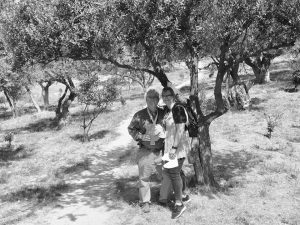

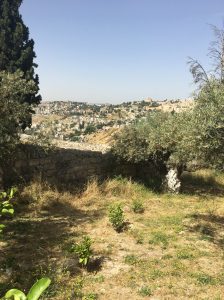
Digging Deep Israel
Digging Deep Israel: Next Stop–Abraham’s Gate at Dan
Posted on February 20, 2020 I love antiques. As I write I’m sitting in an old Windsor chair at a table Glenn built from wood from his grandparents’ old log cabin. My computer backs up to an old embroidered Valentine doily that boasts old blue Mason jars repurposed as candle holders.
I love antiques. As I write I’m sitting in an old Windsor chair at a table Glenn built from wood from his grandparents’ old log cabin. My computer backs up to an old embroidered Valentine doily that boasts old blue Mason jars repurposed as candle holders.
A few months ago, Glenn found an old rock chimney he was able to purchase from which he made me a stone fence around a little kitchen garden area. We spent some months of diligently looking till we found an old iron gate to make an entranceway through the stone wall. I never thought about the difference an old iron gate would make in the nostalgic feel of that little spot.
An old gate. I may have thought I had an old gate outside, but in the Canaanite city of Laish, there’s an OLD gate. This ancient part of Tel-Dan was founded about 6000 years ago and the gate of the city has been unearthed, having been preserved well by a rampart having been erected over it in a later war. 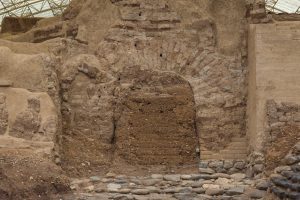
The thrilling thing about this gate is that it seems almost certain to me that Abraham passed through it when he went to rescue Lot in Genesis 14:14. This is the location of Abraham’s travel with the 318 servants that were born in his own house. The gate’s common name today is “Abraham’s gate”.
As I looked at this gate, which is currently undergoing some restoration, I thought about Uncle Abraham going to rescue Lot, for whom he later made the sacrifice of the best land and who ultimately was father to two Canaanite nations that would plague the children of Abraham for centuries: the Moabites and the Ammonites (Genesis 19:37-38). His likely passage through this gate was just a passage through which God was working His own plan for the conquering of the Canaanites, the settling of the promised land, the ultimate birth of the Redeemer in a nation that had passed through the fire of enemy nations and been humbled because of their conformity to those nations. It was a passage through which God was getting us to our promised land around His throne.
The term “old” is relative, for sure. This is an old gate. 
Digging Deep Israel: Next Stop–Jeroboam’s Altar at Dan
Posted on January 15, 2020 Viewing the actual site of the unearthed and reconstructed high place of Jeroboam was one of the ironically low and high points of the trip. I was amazed that I was viewing here the ruins/reconstruction of the physical result of this amazing declaration by Jeroboam:
Viewing the actual site of the unearthed and reconstructed high place of Jeroboam was one of the ironically low and high points of the trip. I was amazed that I was viewing here the ruins/reconstruction of the physical result of this amazing declaration by Jeroboam:
It is too much for you to go up to Jerusalem. Behold your gods, O Israel, who brought you up from the land of Egypt. (1 Kings 12:28)
Rebellious Jeroboam, first king of Israel following the division of 1 Kings, the one who led the rebellion against Rehoboam was clearly paving, for the 10 tribes of Israel, the path to laziness, ease, idolatry and ultimate ruin. He built two gold calves and set up an altar on this hill in Dan and called the people whom God had rescued over and over again, to worship the images in this very place. I wonder how/if Jeroboam would have altered the course if he could have peered through the lens of time and seen this mound of ruin where God’s followers still today lament over the bold departure from the Will of the Sovereign One. I wonder if he would have changed his mind about moving the “mound” of worship to Dan, if he could have known that people 3000 years hence would be reading over 20 passages in the Old Testament in which Jeroboam was described as the sinful one who led Israel into idolatry. I wonder if he would have placed the altar for idol worship in Dan if he had known that the tribe of Dan would be omitted from the genealogies of 1 Chronicles or from the listing of the 144,000 in Revelation 7.
To us today, the altar at Dan shouts an ultimatum: Reverence or ruin.
For those in our religious world today who think it unimportant to work (yes, work) to make our worship pleasing to its Sovereign audience, the altar of Jeroboam stands as a sentinel warning. Worship which disintegrates to an arena of human fulfillment, rather than obeisance (literally, worship means crouching before the high one) to the Infinite One, the path is destruction and omission from eternal blessings.
In practical terms, may we be diligent to put the “work” aspect of our worship in the hearts of our children and at the center of our homes. We do this by preparing for it, praying about it in terms our kids can understand, laying aside our generous contributions ahead of time (and our children’s), making all efforts to be there on time and to be fully engaged, and making sure there is no laughter and visiting with friends during worship. It’s figuratively keeping our worship in Jerusalem and always refraining from “high places” of our own devising.
Digging Deep Israel–Stop #8: Gazin’ at Amazin’ Chorazin!
Posted on December 2, 2019  Jesus said this of first century Chorazin:
Jesus said this of first century Chorazin:
Woe unto thee, Chorazin! woe unto thee, Bethsaida! for if the mighty works, which were done in you, had been done in Tyre and Sidon, they would have repented long ago in sackcloth and ashes. But I say unto you, It shall be more tolerable for Tyre and Sidon at the day of judgment, than for you (Matthew 11:21).
It stirred my soul to think I was standing in the place where many “mighty works” of the Lord were done. The synagogue that we viewed was from the 3rd and 4th centuries, but some of the ruins surrounding it date back to the first century.
Several things are memorable to the Christian viewing the ruins of Chorazin. I’ll always be able to revisit , in memory, the synagogue we saw because the words just kept echoing in my mind “Woe unto thee, Chorazin!” This city that summarily rejected the clear evidence that Jehovah was among them now lies in utter ruin.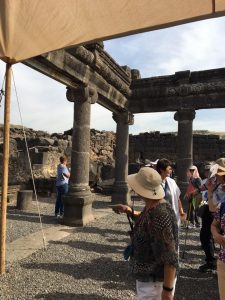 One has to reflect on the truth that the ruin of the architecture has little significance when compared to the eternal ruin and destruction of thousands of souls living in Chorazin during and after the earthly life of the Master Miracle-worker; souls who were so close to the physical evidence of God among them, but turned a blind eye to what was obviously supernatural.
One has to reflect on the truth that the ruin of the architecture has little significance when compared to the eternal ruin and destruction of thousands of souls living in Chorazin during and after the earthly life of the Master Miracle-worker; souls who were so close to the physical evidence of God among them, but turned a blind eye to what was obviously supernatural.
I’ll always remember the seat of Moses in that synagogue, because of the words of the Lord:
The scribes and the Pharisees sit in Moses’ seat: All therefore whatsoever they bid you observe, that observe and do; but do not ye after their works: for they say, and do not. For they bind heavy burdens and grievous to be borne, and lay them on men’s shoulders; but they themselves will not move them with one of their fingers. But all their works they do for to be seen of men: they make broad their phylacteries, and enlarge the borders of their garments, And love the uppermost rooms at feasts, and the chief seats in the synagogues, And greetings in the markets, and to be called of men, Rabbi, Rabbi. But be not ye called Rabbi: for one is your Master, even Christ; and all ye are brethren (Matthew 23:2-8).
 This seat of Moses was elaborately carved of stone and, from it, the law was regularly read by those who were living symbols without substance; proclaiming one thing and doing another. In fact, by the time of the worship of the era we were viewing, the rejection of the Messiah had been persisting in this place for three centuries. The Jews who sat in Moses seat in this place could have read the gospel of Matthew, where the warning about their hypocrisy was given by Christ himself. But they were uninterested in the Messiah, having rejected the powerful testimony—even the resurrection—of the One who gave the stern warning to the residents of the specified town of Chorazin.
This seat of Moses was elaborately carved of stone and, from it, the law was regularly read by those who were living symbols without substance; proclaiming one thing and doing another. In fact, by the time of the worship of the era we were viewing, the rejection of the Messiah had been persisting in this place for three centuries. The Jews who sat in Moses seat in this place could have read the gospel of Matthew, where the warning about their hypocrisy was given by Christ himself. But they were uninterested in the Messiah, having rejected the powerful testimony—even the resurrection—of the One who gave the stern warning to the residents of the specified town of Chorazin.
I saw the Medusa head, one of few preserved, since most of them were apparently 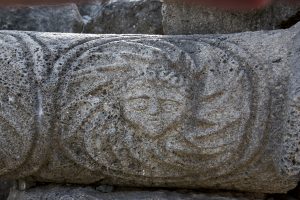 destroyed when the Jews returned to periods of stricter observance of the law; and I observed the underground bath house. Looking at the ruins of the houses in the center of the city, I could see that they were in rows and that families lived in close proximity to one another. I imagined Jewish children running across the narrow lanes and traveling with their parents to the synagogue on the Sabbath. I pondered the tragedy that finally overtook these children when their synagogue and civilization was finally destroyed, likely by an earthquake, in the fourth century. I grieve, even as I write, to understand that many of them died along with their parents on that awful day. I saw the “ghosts” of the innocents clinging to their parents as the earth enveloped them. I heard the screams and the crashing of stones. But to think that those hundreds of adult deaths were the launching points to eternal death and separation from God, is unspeakably difficult to contemplate. Blessed were those, on that day, who were children and separated, at that moment, eternally from the everlasting punishment to be endured by those parents who had rejected the Messiah.
destroyed when the Jews returned to periods of stricter observance of the law; and I observed the underground bath house. Looking at the ruins of the houses in the center of the city, I could see that they were in rows and that families lived in close proximity to one another. I imagined Jewish children running across the narrow lanes and traveling with their parents to the synagogue on the Sabbath. I pondered the tragedy that finally overtook these children when their synagogue and civilization was finally destroyed, likely by an earthquake, in the fourth century. I grieve, even as I write, to understand that many of them died along with their parents on that awful day. I saw the “ghosts” of the innocents clinging to their parents as the earth enveloped them. I heard the screams and the crashing of stones. But to think that those hundreds of adult deaths were the launching points to eternal death and separation from God, is unspeakably difficult to contemplate. Blessed were those, on that day, who were children and separated, at that moment, eternally from the everlasting punishment to be endured by those parents who had rejected the Messiah. 
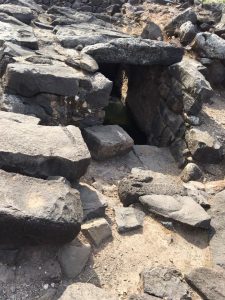
The bath house.
When the Lord issues a “woe”, the hearer (or reader) had best hearken to the warning! How are we doing on finding and heeding the warnings given in the New Testament for us today? It’s an eternally important challenge. Another sobering way to ask this is: If my life tragically and suddenly ended today, would it be better if I’d died in childhood?
Digging Deep Israel–Stop #7: The Sea of Galilee (Kabad all Around!)
Posted on October 10, 2019
 Writing about this stop, I feel like the apostle John when he said, “…And many other signs truly did Jesus in the presence of his disciples, which are not written in this book: But these are written, that ye might believe that Jesus is the Christ, the Son of God; and that believing ye might have life through his name” (John 20:30,31).
Writing about this stop, I feel like the apostle John when he said, “…And many other signs truly did Jesus in the presence of his disciples, which are not written in this book: But these are written, that ye might believe that Jesus is the Christ, the Son of God; and that believing ye might have life through his name” (John 20:30,31).
So many things occurred in Christ’s life in and around this beautiful body of water that I could scarcely scratch the significant surface if I was writing a thick volume, much less a blog post. It was the area from which the apostles predominantly emerged. It was the large lake from which miraculous catches of fish were brought in and cooked by apostolic families and even, on occasion, by the Lord himself (John 21:1-14)…and where once, a fish was caught in a display of glory holding a coin in in it’s mouth—a coin that would teach a lesson that’s still teaching (Matthew 17:24-27). These are the waters that were quieted during a storm by the Master (Mark 4:39) and solidified for His steps (Matthew 14:26). These are the waters that gave him a platform for teaching multitudes and gave Him solace for approaching His Father (Matthew 14:22,23). If the waves today could talk, they would boast of the privilege of being the sea of the Lord. 
And yet they do talk; not miraculously, but they surely whispered his glory to me as I was privileged to sit with Kate and talk about the Lord’s authority in the Digging Deep podcast. The gentle roar of the Galilee wind in our microphones whispered His peace that still solaces. The depths of those mid-sea waters re-told the story of Jesus’ ministry in my meditation as we took our excursion by ship. And as we watched the rising sun from its shoreline singing “Tell Me the Story of Jesus”, moved to tears, I contemplated the reason He was walking this same shore and the dread that, because of His humanity, must have filled each busy day as He grew closer to the cross. As I saw the remains of a first-century fishing boat, recently discovered when the waters of Galilee were very low, I could picture the Lord standing on it’s bow, addressing the shoreline crowd, as he did on that borrowed ship 2000 years ago. (Luke 5:1-4). (Isn’t it profound to think of the Creator stooping to borrow…anything?!)
recently discovered when the waters of Galilee were very low, I could picture the Lord standing on it’s bow, addressing the shoreline crowd, as he did on that borrowed ship 2000 years ago. (Luke 5:1-4). (Isn’t it profound to think of the Creator stooping to borrow…anything?!)
From our little excursion ship, we surveyed the beautiful and surprisingly large lake, also called Gennesaret, and we sang:
The winds and the waves shall obey Thy will…Peace. Be still.
Whether the wrath of the storm-tossed sea,
Or demons or men or whatever it be,
No water can swallow the ship where lies
The master of ocean and earth and skies.
They all shall sweetly obey Thy Will
Peace. Be still.

Kabad was everywhere around us!
(Master, the Tempest is Raging;
Text: Mary Ann Baker, ca. 1874′ ,Music: H. R. Palmer, 1834–1907)
 The next stop on our tour was Jericho. I will always remember this stop as the place where I rode the camel and permanently lost my i-phone while riding; but there are some very faith-building events in history that should make Jericho a favorite stop for any Bible student traveling in Israel. So, today, a short synopsis.
The next stop on our tour was Jericho. I will always remember this stop as the place where I rode the camel and permanently lost my i-phone while riding; but there are some very faith-building events in history that should make Jericho a favorite stop for any Bible student traveling in Israel. So, today, a short synopsis.
We know Jericho as the first great city of Canaan conquered by the Israelites. You remember it was the home of the harlot Rahab (She likely lived between the thick double-walls of the city) who hid the spies, sent by Israel to search out the land. She had heard great things about Jehovah. She feared Him and, because of this faith and her willingness to help the enemy of her own people of Jericho, was spared in the great destruction that followed the marching around the city for seven days by the people of God. You can read about the covenant the spies made with Rahab in the latter part of Joshua 2 and about the destruction of Jericho in Joshua 6.
 It’s very interesting to read from archaeologists who’ve studied ancient Jericho. In the mid- 1950s, Kathleen Kenyon did extensive work in Jericho and published her findings, largely debunking the Biblical account, premising that the archeological evidence discredits the Biblical account. Published during an era when much of the world was all about discrediting the Word of God and throwing off its authority, her study was widely read and accepted.
It’s very interesting to read from archaeologists who’ve studied ancient Jericho. In the mid- 1950s, Kathleen Kenyon did extensive work in Jericho and published her findings, largely debunking the Biblical account, premising that the archeological evidence discredits the Biblical account. Published during an era when much of the world was all about discrediting the Word of God and throwing off its authority, her study was widely read and accepted.
But in 1990, an article in Biblical Archaeology Review (a journal that definitely does not adhere to any literal interpretation of Scripture) published quite the opposite view. When perusing the findings that are the basis of this article, one is stricken with the amount and weight of the evidence that the invasion and destruction of Jericho happened at the time and in the manner that the first few chapters of Judges relates. I would advise the reading of this article in Christian Courier. It will build your faith and make you glad that you serve Jehovah! It’s here: https://www.christiancourier.com/articles/56-saga-of-ancient-jericho-the
 In the Jericho area today, there’s a modern city. Just outside this city, now in the political West bank (thus under Muslim rule), over 20 civilizations have been unearthed; so Jericho is a tel in the expansive sense of the word, for sure. It’s a stacked succession of ruins of conquering civilizations. (The fact that we can unearth layers of stacked civilizations should remind us of the temporary nature of our current way of life.) The demise of our “way of life” is certain and, thus, always pending.
In the Jericho area today, there’s a modern city. Just outside this city, now in the political West bank (thus under Muslim rule), over 20 civilizations have been unearthed; so Jericho is a tel in the expansive sense of the word, for sure. It’s a stacked succession of ruins of conquering civilizations. (The fact that we can unearth layers of stacked civilizations should remind us of the temporary nature of our current way of life.) The demise of our “way of life” is certain and, thus, always pending.
As God foresaw the layers of a tel, He made a judgment promise in Judges 6:26:
Joshua laid an oath on them at that time, saying, “Cursed before the Lord be the man who rises up and rebuilds this city, Jericho.
“At the cost of his firstborn shall he
lay its foundation,
and at the cost of his youngest son
shall he set up its gates.”
In I Kings 16:34, some 700 years after the prophecy that whoever rebuilt the city would pay for it with the loss of both his oldest and youngest sons, Hiel, the Bethelite did just that, and his sons were the bulk of the purchase price for this real estate tycoon, who failed to do the spiritual research (or failed to believe it) regarding the investment required for this first renovation of Jericho.
Ten quick and obvious lessons from Jericho for your September day:
- Always, like Rahab, examine the evidence for yourself. Don’t let the culture around you sweep you up in it’s ever-changing philosophies.
- Obey the details of Scripture for your eternal escape. Rahab could have deviated from precision in many ways, but she did not.
- Like Rahab, do your best to save your household.
- God can do anything He wants to do, using whatever implementation he chooses. Marching and trumpets for defeat of a large civilization?!! Bring it on!
- No matter the taunting of today, the great pending eternal salvation will be worth the ridicule!
- Harlots are worth saving. Redeemed people are honored beyond belief in God’s economy (Matthew 1:5).
- The passage of large amounts of time is no object in the keeping of God’s promises. Don’t be lulled, like Hiel, while you wait for judgment.
- Be like Rahab, who saved her household for righteousness; not like Hiel who sacrificed his for economic profit.
- Our God’s glory is dependent on His promise-keeping. His promise, through the spies, to Rahab; His promise to the marching Israelites; His promise to the re-builder of Jericho…all of these came down toward a glorious moment of redemption that was in the preparing.
- Like Rahab, befriend the people of God, even if it means threat to your safety or well-being. God has a way of making our righteous, but dangerous paths His opportunity to mightily prevail.
